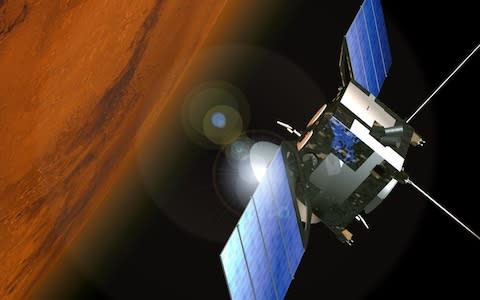Lake of water detected on Mars raises hope of life beneath the surface

A 12-mile long lake of liquid water has been detected under the polar ice caps of Mars, raising hopes that life could exist beneath the surface.
Scientists operating ground-penetrating radar on board the European Space Agency’s Mars Express spacecraft, which is orbiting the red planet, announced the finding on Wednesday, ending decades of speculation.
The huge body of water exists about one mile beneath the southern Martian ice cap and appears similar to Lake Vostok, which was found 2.4 miles beneath Antarctica and contained more than 3,500 species.
"This thrilling discovery is a highlight for planetary science and will contribute to our understanding of the evolution of Mars, the history of water on our neighbour planet and its habitability,” said Dmitri Titov, ESA's Mars Express project scientist.
"The long duration of Mars Express, and the exhausting effort made by the radar team to overcome many analytical challenges, enabled this much-awaited result, demonstrating that the mission and its payload still have a great science potential.”

Mars Express launched 2 June 2003 and will have spent 15 years in orbit by 25 December this year.
Scientists have long suspected that liquid water was once abundant on Mars because of evidence of dried up lake and river beds. It was also suspected water may exist under the polar caps because the melting point of water decreases beneath a glacier.
The radar investigation showed that south polar region of Mars is made of many layers of ice and dust down to a depth of about one mile but then changes to the signature of water.

"This subsurface anomaly on Mars has radar properties matching water or water-rich sediments," said Roberto Orosei, principal investigator of the MARSIS experiment and lead author of the paper published in the journal Science.
"This is just one small study area; it is an exciting prospect to think there could be more of these underground pockets of water elsewhere, yet to be discovered.
"We'd seen hints of interesting subsurface features for years but we couldn't reproduce the result from orbit to orbit, because the sampling rates and resolution of our data was previously too low.”

 Yahoo News
Yahoo News 
